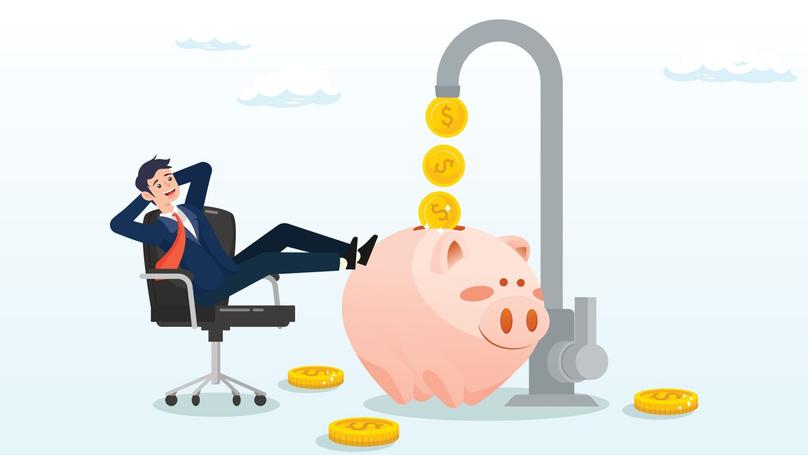Passive income

What is passive income?
Passive income is income that you receive without putting any (or almost any) effort into it and without devoting personal time to it. Passive income is often defined as additional rather than primary income because it is usually insufficient to cover all needs. Additionally, due to the large amount of free time that passive income allows, the person still often maintains a primary job. This also implies that passive income can be earned directly from home. For example, passive income can come in the form of interest from a transaction or investments, royalties, monthly deductions, or passive sales, which also occur automatically without your direct involvement.
Most passive income options require an initial investment since the source of such income is not created instantly and is a kind of project (usually long-term; that is, it takes time for passive income to pay for itself and become real income). Today, almost anything, including hobbies and other activities, can be turned into a source of passive income with the help of automation technologies and online tools.
Difference between active and passive income
Active income is money earned through physical or mental work, typically for a set number of hours. It's the result of your efforts and the resources you invest, be it your strength, knowledge, or time. While passive income requires effort only at the initial stage of creation, active income stops coming in when you stop working, meaning it directly depends on it and is generally proportional to the efforts made.
Here are the main ways to generate active income that cannot be considered passive, even if these methods do not require as much time from you as other people:
- Traditional office work. Or even if you work remotely or with a flexible schedule, if the work is easy for you and brings fabulous amounts, if you are a freelancer - this is still NOT passive income, since passive income does not require involvement in the process of earning it.
- Your business. A business can become a source of passive income only if you hire a full staff with the CEO and simply own a share in your company and receive a part of its income. In other cases, if you are the CEO and, in one way or another, participate in the conclusion of deals, search for partners, or are involved in some business operations, this is still active income.
- Part-time or leisure-time work. For example, part-time work as a taxi driver or walking neighbors' pets. The key word here is work, even if part-time, so this is also an active income.
Thus, active income is generated by your performance of certain tasks, regardless of their complexity, while passive income comes continuously, regardless of your actions, even during complete inactivity or in your absence. Below, we will analyze the best forms of passive income.
Types of passive income
There are several types of passive income:
- Investment (or financial), when the source of passive income is investment instruments or banking offers, for example, bonds, interest on deposits, etc.
- Property income, that is, receiving income from renting out property, transportation, personal items, equipment, and anything else that belongs to you but is temporarily transferred to other individuals.
- Intellectual-creative, that is, passive income sources that were created on the basis of your creative ideas or mental activity. For example, scripts for movies or books, recorded online courses, soundtracks, and anything that is bought or for which you are paid a percentage for use by other people or in third-party projects.
- Marketing. In this case, you get money for advertising online or offline. For example, you place referral links on social networks, for clicking on which you make a profit, or make an advertising print on the door of your car in favor of a particular company (yes, this also exists).
Sometimes, there is a fifth type of passive income-social. However, it is not available to everyone, and it is almost impossible to regulate it since it is usually understood as various benefits, such as pensions, survivor's payments, etc. In other words, it is a forced and auxiliary source of passive income created by circumstances rather than by the person's will and efforts.
A source of passive income can also be permanent or seasonal. If it is a one-time or two-time income, even if it comes without your efforts, it is still not passive income. To be considered passive, income must be continuous and "reusable." Of course, it is impossible to build a perpetual passive income: one way or another, your participation will still be required at a certain period of time, For example, for equipment maintenance, apartment repairs, confirmation of some documents, etc.
How to make passive income

As mentioned above, you can turn almost anything into a source of passive income, but what works best in your case is a question. Use our guide to find out and create a passive income source that will best meet your needs and last as long as possible:
Step 1. Assess your current capabilities. It's not just about the free money that you have at the moment, thanks to active income, and that you can invest in creating a source of passive income, but also about time, knowledge, and other resources that can be used. Let's say you have unique expertise thanks to many years of experience in the same niche, solid connections, or a lot of time, which, if necessary, you can devote to creating a source. Write down everything you have now on a piece of paper and prioritize which of these is the easiest to use, which ones you want to use yourself, etc.
Step 2. Determine your goals and needs. Why do you need a source of passive income? If you expect that one day it will be able to replace your active one and you will be able to completely switch to it, then you will have to invest much more in such a source at the start, as you need to count not on a quick, but on a long-term profit with a slow payback. On the contrary, if you just want to receive a nice bonus to your salary, this will require less effort, and you can consider the easiest ways. Or you, for example, want to have passive income to save money for travel or retirement - in this case, you need to look towards stable and long-term sources with an average profit.
Step 3. Decide on a direction. Based on the previous steps, gather all the forms of passive income available to you and choose the ones that seem most promising and rational to you. You may want to try several at once, but start with one and give it a "trial period." If one source doesn't work out, you can always try another.
Step 4. Gather information about the direction you want to take. You need to draw up an action plan to create a source, and for this, you will need to analyze relevant data about your niche and similar cases. Do you know someone with this type of passive income? Can you ask them to share their experience? You can also read interviews or autobiographies of people who have experience with such sources and study specialized literature if your source requires special knowledge. The main thing is to find answers to all your questions that will inevitably arise in the preparation process, take into account possible risks (which are especially important when using investment instruments), and calculate the costs, payback, potential profit, and prospects of the source.
Step 5. Analyze the risks. It's best to put this in a separate step, as even passive income can come with unexpected costs. So, if you plan to rent out an apartment, then you need to be prepared for the fact that after a while, you will have to redo repairs after careless tenants or spend money on fixing the washing machine if it suddenly breaks down (or write in the contract that the tenants themselves do it, and thus minimize the risks). You should assess in advance the cost of depreciation if we are talking about equipment, the cost and location of housing, if you are going to specifically buy an apartment for further rent, the volatility of the investment instruments you have chosen, etc.
Is passive income taxable?
When answering the question of whether passive income is taxed, it is necessary to look at the legislation of a particular country, but, as a rule, most countries do provide for such taxation. However, the tax may differ from the tax that applies to active income sources since they have different methods of generation and most often vary in amounts. Yet, there are several factors to consider, such as:
- Rental properties are taxed in the same way as ordinary income. This income is all rental payments, from insurance premiums to utility bills, but operating expenses and repair costs can be deducted from them.
- Dividends, i.e., income from holding shares, are taxed depending on whether they are classified as ordinary or qualified. Ordinary dividends are taxed as ordinary, and qualified dividends are taxed as capital gains.
- Interest on a savings account. This interest is also taxed as on ordinary income, but usually banks already calculate it and charge it themselves when transferring interest.
If you have your own store with automated sales or with sales made by your staff without your participation, the income from this store will be taxed according to the rules of the trading activity and will also not be considered passive. Different countries also have different ideas about passive income. For example, in the United States, passive income can be considered royalties, which are payments made by a licensing company to the owner of a copyrighted product for the use of software developed by an individual. However, taxes may still apply if the software was obtained as a result of the owner's business and not as a result of a transfer of rights.
The short answer to the question about taxes is that different ways to make passive income imply a different passive income tax rate. The amount and obligations of this tax are determined by the legislation of a particular country and the type of source of income.
Top passive income ideas in 2024

Let's look at examples of passive income, as well as those methods that are universal or that can help you find your individual strategy.
Make money by investing
This method is based on buying financial instruments and making money on their storage and appreciation of their price on the market. In order to choose them correctly, however, you need preparation, preliminary market research, and investment knowledge, which can be obtained, for example, in the Lectera course "Investing in Simple Language." Here are the best passive income investments:
- Stocks. Here, you will receive dividend income, which is a part of the income from the company's profits. This means that it will come to you regularly, but it is not known in what amount since this income is not fixed and will depend on the efficiency and profitability of the company at the moment. That is why it is undesirable to buy shares of only one company. It is even better to choose different sectors of the economy, as they will react differently to the crises and events taking place in the world. Also, consider the investment rule that if you want to live only on dividends, you need to invest at least 100 times more in stocks than you want to receive monthly.
- Bonds. In this case, the investor does not receive a percentage of the company's profits but cashes out coupons purchased from the company for a certain percentage from one to four times a year for fixed amounts. There are fewer risks, but the profit is lower. It is best to combine bonds with stocks in the portfolio.
- Bank deposits are the most understandable and affordable source of passive income, with a fixed but low-profit margin that usually only covers inflation (and even then, not always). However, private and small banks can offer a high interest rate on deposits, so they are still a popular investment instrument with minimal risks (since investments are insured by the bank).
- Сrypto instruments. This is a relatively new investment instrument with high profitability but also high risks. A passive tactic is to buy some cryptocurrency at a decline in value, "forget" about it for a few years and then check its price. Some cryptocurrencies, like Bitcoin, skyrocketed over time. You can even buy BTC itself for a minimum amount. This method is NOT recommended for beginner investors.
Rent
You can rent out and passively earn on almost anything, for example:
- Real estate. This is the most popular and relatively easy passive income method, which, however, will require a very large initial capital from you if you want to buy a property specifically for rent. But this is a source of income that will increase along with prices on the market; that is, you will be able to increase the cost of rent over time.
- Car. For example, you may have a car but rarely use it, perhaps only when you need to go somewhere out of town. Instead of keeping it in the garage, you can rent it out to other people on a daily basis. However, it is important to consider maintenance costs and risks, such as accidents, contamination of the interior, etc. It is possible to compensate for all this, however, through appropriate contracts or insurance policies.
- Storage. It can even be a basement or attic where you will store other people's belongings for money. Many retailers and ordinary people need additional space, for example, to store packaging materials or use it as an intermediate delivery point from where the goods will be picked up and redirected by couriers.
- Accommodation. Special platforms, such as Airbnb, allow you to rent out a room in your apartment to travelers for a day, for example. All you need is photos of the room, proof of your identity, and a willingness to receive guests from time to time.
- Tools, equipment, machinery. For example, some people rent out Playstations, which is great for students and young adults. An example would be a sewing machine, which is specialized equipment.
Create a course
This method is suitable for those who already have a certain level of expertise in a particular niche and, therefore, knowledge that can be processed and "packaged" into a course. Of course, this will require time, energy, and appropriate skills, such as sound recording, editing, etc., but such a course can continuously bring you profit for years unless it contains information that tends to become outdated, for example, something about artificial intelligence. Courses about soft skills or investing will always be relevant.
You can sell such courses on specialized self-study platforms, such as Udemy and Coursera. So, the amount for the purchase of the course (minus the platform commission) will be regularly credited to your bank card without your participation. You can also consider the freemium model, which attracts subscribers with free content (say, part of a course) and gives them access to the full version of the course for a paid subscription. This method is more effective in cases where you intend to further develop in the field of online education and want to promote your blog or project.
Important! For an online course to truly become a stable source of passive income for you, the knowledge in it must be truly valuable, professional, and relevant. Make sure that you are an expert in what you are going to teach, and do not forget that in the beginning, your course will also need promotion so that as many people as possible learn about it.
Advertise on the blog
Having your own blog opens up a lot of new opportunities for passive income opportunities. In this case, you are essentially selling space for digital advertising - the same as placing an advertising inscription on the hood of your car for a fee (which, by the way, is also a possible way to make money!). In this case, you will first need to get a personal blog and promote it, that is, have a solid audience that advertisers can access through you. For example, if you have your own channel on YouTube or Telegram. There are special platforms for finding advertisers, where you fill in information about your channel and audience. Willing companies find you and order this or that integration or post from you.
Important! Sometimes, however, your participation will still be required. For example, if you prepare the integration to make it native, you need to write the text, edit the video, or approve it.

Sell photos or music on stocks
This method is suitable for you if photography or music is already your hobby. In this case, you will not have to allocate additional time for this; it will be exclusively passive income and not half active. Let's say you're an amateur photographer. Post your photos on a paid photo stock site, where businesses and individuals can purchase rights to them for commercial or personal use. The amounts are usually small, but the more photos, the higher the earnings.
The same can be done with music if you programmatically generate or create your own tracks, sound effects, etc. It is enough to record a few melodies, even in a home studio, and upload them to a stock site, where people can buy them and use them in their videos, on websites, etc. You will earn passive income for using them as an author by receiving a percentage.
Publish a book
Obviously, this method is not for everyone, but for creative people who enjoy writing and who already have some stashed texts. You can always pull them out and send them to the publishing house. Even small editions will bring you good royalties (as a rule, once a quarter or six months). Moreover, it does not have to be fiction; you can also write:
- popular science, if you are an expert in a topic, for example, a psychiatrist (consider it an alternative to an online course);
- a recipe book;
- collections of stories or poems;
- various textbooks, cheat sheets, and even brochures;
- artbooks, if you're an artist.
Publishing books can also be done electronically and independently, which is much easier and more profitable in today's world than publishing on paper.
Join the affiliate program
In fact, affiliate marketing is when you promote third-party products rather than your own. Affiliate marketing comes in different levels of engagement. For example, you can sell these products yourself by becoming a distributor and developing your network of the same sellers along the chain, but this will already be active income, not passive. As part of passive income, it is enough to place a link everywhere, for clicking on which you will accrue interest in the company's personal account and, accordingly, earn passive income.
Many companies, however, require the user who clicks on your link to sign up or make a purchase for something before they transfer you a percentage for it. This is also called a referral program or "bring your friends." In practice, it looks like this: you generate your unique link on a company's website with an affiliate program and place it wherever possible, from personal social networks to a special blog designed specifically to promote the products "entrusted" to you. You can also send this link by email (but be careful with spam!) or actually send it to your friends.
Important! In order to get a tangible passive income from an affiliate program, you will need really high traffic to your link, so it is best to combine this method with blogging, running a channel, etc. You'll also have to spend some time periodically posting your link somewhere else, unless you find a way to attach it to a page/site/point that will constantly receive fresh traffic on its own. For example, it is enough to place a referral link in the description of your most popular video on YouTube, which has become a kind of "immortal classic" and constantly brings you new views, although it has been published for a long time.
Create an app
It is a source of passive income with a long-term perspective, which, however, will require you to have special knowledge in development and strategy. After all, a smart app should be functional, user-friendly, and useful, that is, to help the user achieve certain goals. Ensure you have the necessary certificates to release the app to licensed mobile services such as the App Store and keep in mind that apps need to be updated as device operating systems are updated. So this is quite painstaking and long work, but very profitable since the owner of the application receives a percentage for each download or purchase of a paid subscription to it.
Buy a vending machine franchise
A franchise is the purchase of a small business within one large retail chain, where everything is already put on track and does not require direct intervention, the development of a unique business strategy, etc. It will be passive if your intervention in it is reduced to zero, and only a vending machine, a kind of budget mini-version of your own business, can provide this.
For example, a coffee machine can be installed in a shopping center. You will only need to replenish its stocks or assign a person to monitor it. The main advantage is that such machines usually require investment with little money compared to the franchise of a full-fledged business.
Conclusion
Passive income is the dream of many, but it is usually additional and cannot cover all the costs of living alone. The easiest way to generate passive income is to monetize what you already have, such as knowledge, hobbies, real estate, etc. The more you invest in it, the more profit it will bring later. Therefore, it is very rare to create passive income with no money; most often, income that has been active for some time turns into it. Try different passive income strategies and methods, invest, and study the market until you find your true source!























